AUDI A5 COUPE 2012 Owners Manual
Manufacturer: AUDI, Model Year: 2012, Model line: A5 COUPE, Model: AUDI A5 COUPE 2012Pages: 316, PDF Size: 78.59 MB
Page 251 of 316
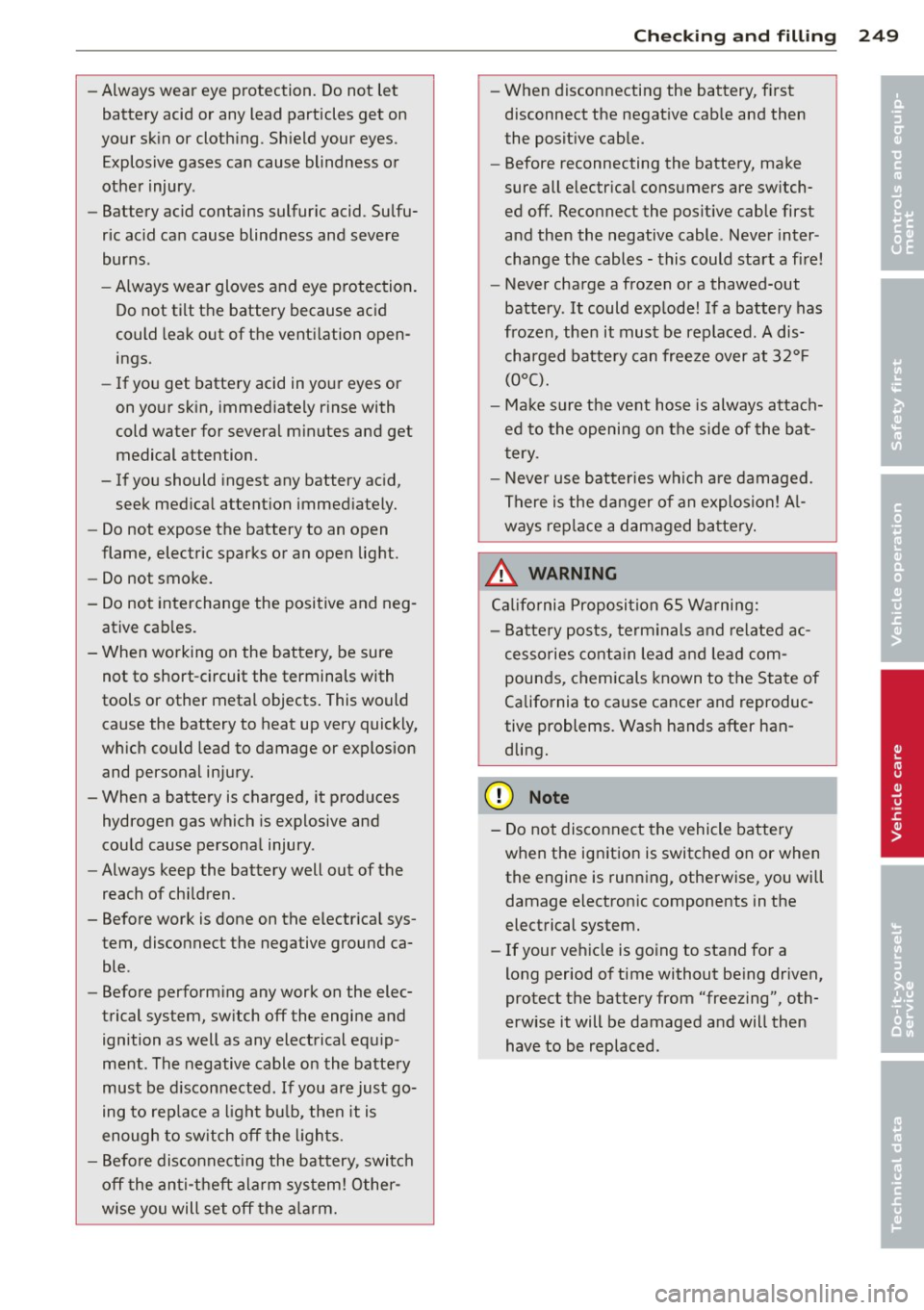
-Always wear eye protection. Do not let
battery acid or any lead particles get on
your skin or clothing. Shield your eyes .
Explosive gases can cause blindness or
other injury.
- Battery acid contains sulfuric acid . Sulfu
ric acid can cause blindness and severe
burns.
- Always wear gloves and eye protection.
Do not tilt the battery because acid
could leak out of the ventilation open
ings.
- If you get battery acid in your eyes or
on your skin, immediately rinse with
cold water for several minutes and get
medical attention .
- If you should ingest any battery acid,
seek medical attention immediately.
- Do not expose the battery to an open
flame, electric sparks or an open light.
- Do not smoke.
- Do not interchange the positive and neg-
ative cables .
= When working on the battery, be sure
not to short-circuit the terminals with
tools or other metal objects. This would cause the battery to heat up very quickly,
which could lead to damage or explosion and personal injury.
- When a battery is charged, it produces
hydrogen gas which is explosive and
could cause personal injury .
- Always keep the battery well out of the
reach of children.
- Before work is done on the electrical sys
tem, disconnect the negative ground ca ble .
- Before performing any work on the elec
trical system, switch off the engine and
ignition as well as any electrical equip
ment. The negative cable on the battery
must be disconnected . If you are just go
ing to replace a light bulb, then it is
enough to switch off the lights.
- Before disconnecting the battery, switch
off the anti-theft alarm system! Other
wise you will set off the alarm.
Checking and filling 249
-When disconnecting the battery, first
disconnect the negative cable and then
the positive cable.
- Before reconnecting the battery, make
sure all electrical consumers are switch
ed off. Reconnect the positive cable first
and then the negative cable . Never inter
change the cables -this could start a fire!
- Never charge a frozen or a thawed-out
battery . It could explode! If a battery has
frozen , then it must be replaced . A dis
charged battery can freeze over at 32°F
(QOC),
-Make sure the vent hose is always attach
ed to the opening on the side of the bat
tery .
- Never use batteries which are damaged.
There is the danger of an explosion! Al
ways replace a damaged battery.
&_ WARNING
California Proposition 65 Warning:
- Battery posts, terminals and related ac
cessories contain lead and lead com
pounds, chemicals known to the State of
California to cause cancer and reproduc
tive problems. Wash hands after han dling.
(D Note
- Do not disconnect the vehicle battery
when the ignition is switched on or when the engine is running, otherwise, you will
damage electronic components in the
electrical system.
- If your vehicle is going to stand for a
long period of time without being driven,
protect the battery from "freezing", oth
erwise it will be damaged and will then
have to be replaced.
•
•
Page 252 of 316
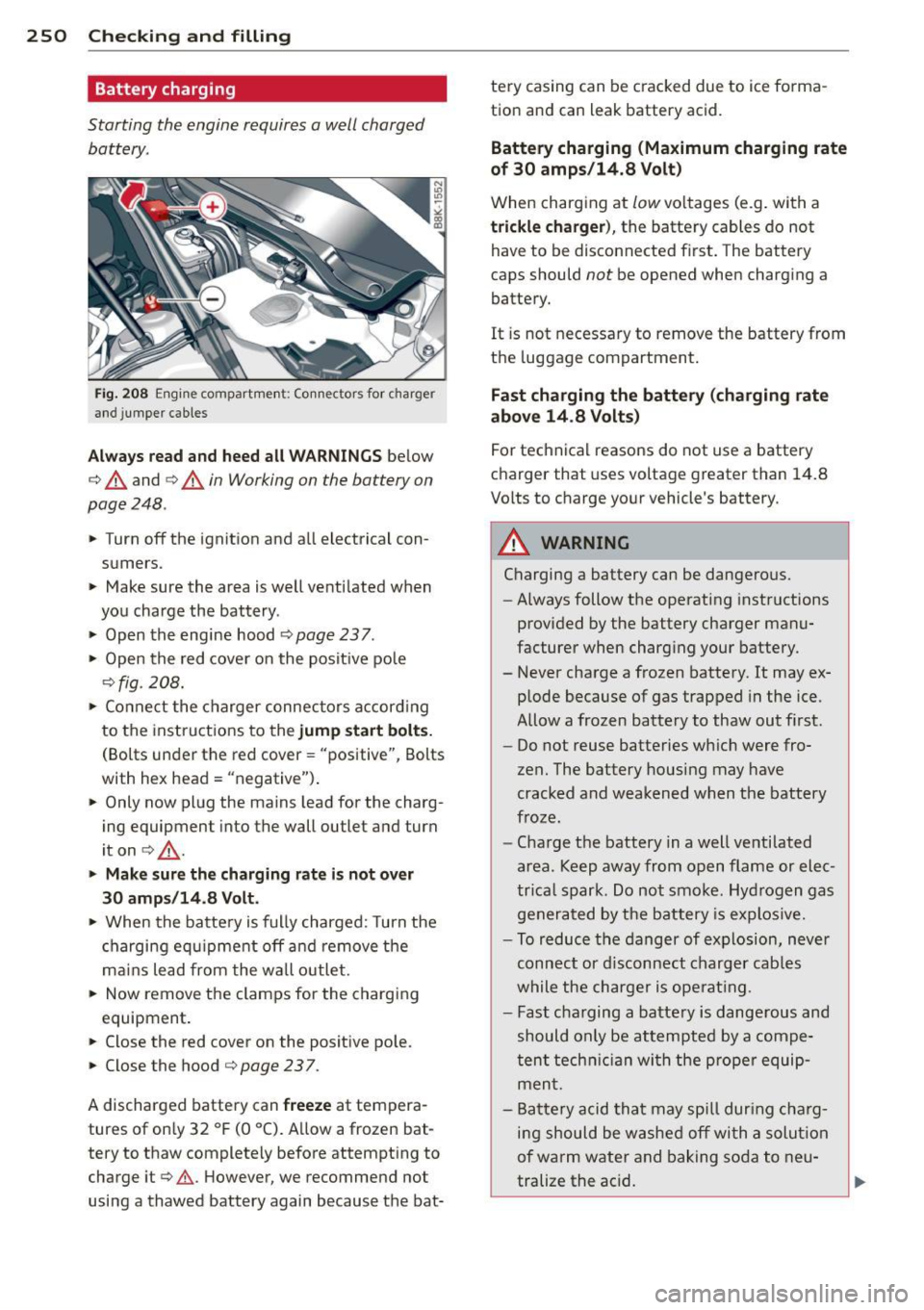
250 Checking and filling
Battery charging
Starting the engine requires a well charged
battery.
Fig. 208 Engine compartme nt: Connectors for charger
and jumper cables
Always read and heed all WARNINGS below
c:> A and c:> A in Working on the battery on
page 248 .
.,. Turn off the ignition and all electrical con
sumers.
> Make sure the area is well ventilated when
you charge the battery .
> Open the engine hood r:::.> page 237 .
> Open the red cover on the posit ive pole
<::.>fig . 208.
> Connect the charger connectors according
to the instructions to the
jump start bolts.
(Bolts under the red cover= "positive", Bolts
with hex head= "negative") .
> Only now plug the mains lead for the charg
ing equipment into the wall outlet and turn
iton
c:> &_ .
.,. Make sure the charging rate is not over
30 amps/14.8 Volt.
> When the battery is fully charged: Turn the
charging equipm ent off and
remove the
mains lead from the wall outlet.
> Now remove the clamps for the charging
equipment.
.,. Close the red cover on the positive pole.
> Close the hood c:> page 23 7.
A discharged battery can freeze at tempera
tures of on ly 32 °F (0 °C). Allow a frozen bat
tery to thaw completely before attempting to charge it
c:> .&. However, we recommend not
using a thawed battery again because the bat- tery casing can
be cracked due to ice forma
tion and can leak battery acid.
Battery charging (Maximum charging rate
of 30 amps/14.8 Volt)
When charging at low voltages (e.g. with a
trickle charger), the battery cables do not
have to be disconnected first. The battery
caps should
not be opened when charging a
battery.
It i s not necessary to remove the battery from
the luggage compartment.
Fast charging the battery (charging rate
above 14 .8 Volts)
For technical reasons do not use a battery
charger that uses voltage greater than 14.8
Volts to charge your vehicle's battery.
A WARNING
-----=--
Charging a battery can be dangerous.
- Always follow the operating instructions
provided by the battery charger manu
facturer when charging your battery.
- Never charge a frozen battery. It may ex
plode because of gas trapped in the ice.
Allow a frozen battery to thaw out first.
- Do not reuse batteries wh ich were fro
zen. The battery hous ing may have
cracked and weakened when the battery
froze.
- Charge the battery in a well ventilated
area . Keep away from open flame or elec
trica l spark. Do not smoke. Hydrogen gas
generated by the battery is explos ive.
- To reduce the danger of explosion,
never
connect or disconnect charger cables
while the charger is operating.
- Fast charging a battery is dangerous and
should only be attempted by a compe
tent technician with the proper equip
ment.
- Battery acid that may spill during charg
ing should be washed off with a solut ion
of warm water and baking soda to neu-
tralize the acid. ....
L..__ _____________ _J ...
Page 253 of 316

CD Note
Never use a fast charger as a booster to
start the engine. This will seriously dam
age sensitive electronic components, such
as control units, relays, radio, etc., as well
as the battery charger.
Battery replacement
The new battery must have the same specifi
cations and dimensions as the original equip
ment battery.
Intelligent energy management in your vehi
cle is responsible for distributing the electri
cal energy throughout your vehicle
c::, page 211. The intelligent energy manage
ment system w ill keep the engine battery
charged bette r then ve hicles w ithout this sys
tem. To ma ke sure t he addi tional e lectrical en
ergy is available once again after you have
changed the battery, we recommend that you
install batteries of the same type and man u
facture only (the same as those installed at
the time your vehicle was delivered). Specifi
cations are listed on the battery housing. Your
author ized Audi dealer must code the battery
i n the energy management system to enable
you to use the energy management functions
correctly after replac ing the bat tery .
If it is not possible to use a battery of this
type, the new battery must have the same ca pac ity, voltage (12 volts), amperage, con
s truction and pl ug seal ing .
When insta lli ng the battery, make sure the ig
ni tion and all e lectr ica l cons umers are turned
off.
(0 Note
Ma ke sure the venti lation hose on the s ide
of the battery is connected, othe rwis e
fumes or battery ac id can leak out.
@ For the sake of the environment
Because of the problem of proper d isposa l
of a batte ry, we recommend your author
ize d Au di dealer change th e batte ry for
Checkin g and fillin g 251
you. Batteries contain sul fur ic acid and
l ead and must always be disposed of prop
erly in comp liance with a ll environmental
regulations. Disposing of vehicle batter ies
i mproperly is very dange rous to the envi
r o nment .
Windshield/headlight*
washer container
Fig . 20 9 En gin e compa rtm ent : W inds hield an d head
light• washer fluid co ntai ne r
The was her fluid conta iner is mar ked w ith the
symbol Won its cap.
.., Before you check any thing in the engine
compa rtment,
alwa ys read and heed all
WARNINGS ~ .&_ in Working in the engine
compartment on page 23
7.
.., Lift the fi lle r ca p tongue to add washer flu
id. You can fi ll the containe r to t he top .
.., Press the cap back onto t he fi ller neck after
filling the container.
You can find the reservo ir
capacity in the table
in
c::> page 292.
Clean water should be used when filling up. If
poss ible, use soft wa ter to prevent scaling on
the washer jets . Always ad d a glass cleaner
solution (with frost protection in the winter) .
CD Note
Do not mix engine coola nt antifree ze o r
any other additives to fill up t he wind
sh ield washer reservoir .
Page 254 of 316
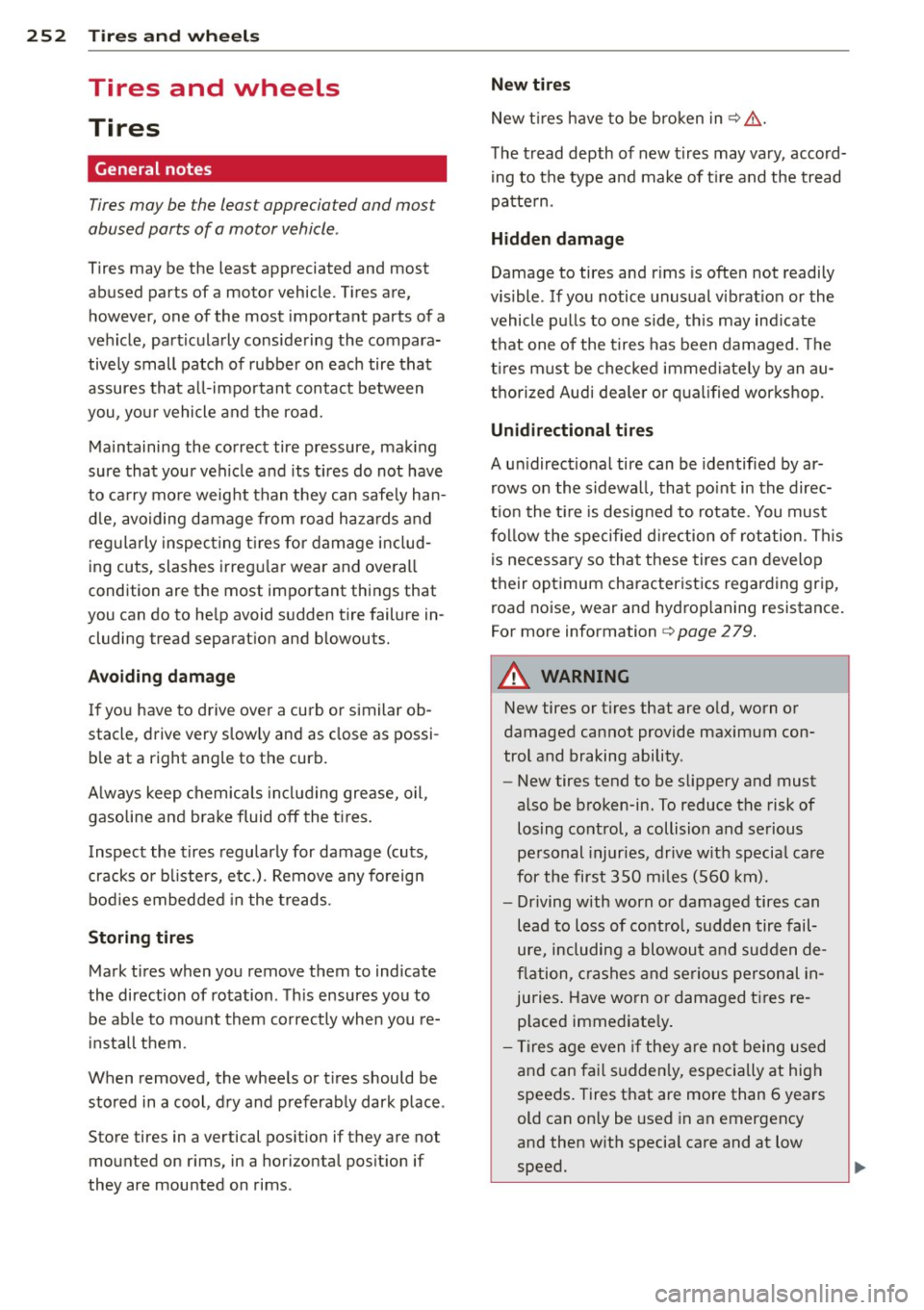
252 Tire s and wheel s
Tires and wheels
Tires
General notes
Tires may be the least appreciated and most
abused parts of a motor vehicle .
Tires may be the least appreciated and most
abused parts of a motor vehicle . Tires are,
however, one of the most important parts of a
vehicle, particularly considering the compara
tive ly small patch of rubber on each tire that
assures that a ll-impo rtant contact between
you, your vehicle and the road.
Maintaining the correct tire pressure, mak ing
sure that your vehicle and its tires do not have
to carry mo re weight than they can safe ly han
d le, avoiding damage from road hazards and
reg ularly inspecting t ires for damage includ
ing cuts, slashes irregu la r wear and ove rall
condition are the most important things that
you can do to he lp avoid sudden tire failure in
cluding tread separation and blowouts.
Avoiding damage I f you have to drive over a curb or similar ob
stacle, drive very s low ly and as close as possi
b le at a right angle to the curb.
A lways keep chem ica ls includ ing gre ase, o il,
gasoline and b rake fluid off the ti res .
Inspect the t ires regularly for damage (cuts,
cracks or b listers, etc.). Remove any fo reign
bod ies embedded in the treads.
Storing tires Mark tires when you remove them to indicate
the direction of rotation . Th is ensures you to
be ab le to mount them correctly when you re
install t hem.
When removed, the whee ls or t ires should be
stored in a cool, d ry and preferably dark place .
Store tires in a vertical pos ition if they are not
mounted on rims, in a horizontal pos it ion if
they are mounted on rims. New tire
s
New t ires have to be broken in¢&,. .
T he tread depth of new t ires may vary, accord
ing to the type a nd make of t ire and the tread
pa tte rn .
Hidden damage
Damage to tires and r ims is ofte n not readily
vis ible . If you notice unusual v ibrat ion or the
vehicle p ulls to one side, th is may ind icate
t h at one of the t ires has been damaged . Th e
t ir es m ust be checked immed iate ly by an au
tho rized Aud i dea le r or q uali fied wor ks hop.
Unidirectional t ires
A un idirectional tire can be identified by ar
rows on the sid ewa ll, that po int in the direc
t ion the t ire is desig ned to rotate. You mus t
f ol low the specified d irection of rotation . This
is necessary so that these tires can develop
their optimum characterist ics regarding grip,
road no ise, wear and hyd rop laning resistance.
For more information ¢
page 2 79.
A WARNING
-New tires or tires that are old, worn or
damaged cannot provide maximum con
trol and braking ability .
-
-New tires tend to be slippery and must
also be broken-in. To reduce t he risk of
losing control, a collision and se rious
pe rsonal injuries, drive w it h specia l care
for the first 350 miles (560 km).
- Driving with worn or damaged tires can
le ad to loss of control, sudden tire fail
ure, including a blowou t and sudden de
fl ation, c rashes and seriou s personal in
juries . Have wo rn or damaged t ires re
p laced immediate ly .
- T ires age even if they are not being used
an d can fai l sudden ly, especially at high
speeds. Tires that are more than 6 years
old can only be used in an emergency
and then w ith specia l care and at low
speed.
Page 255 of 316
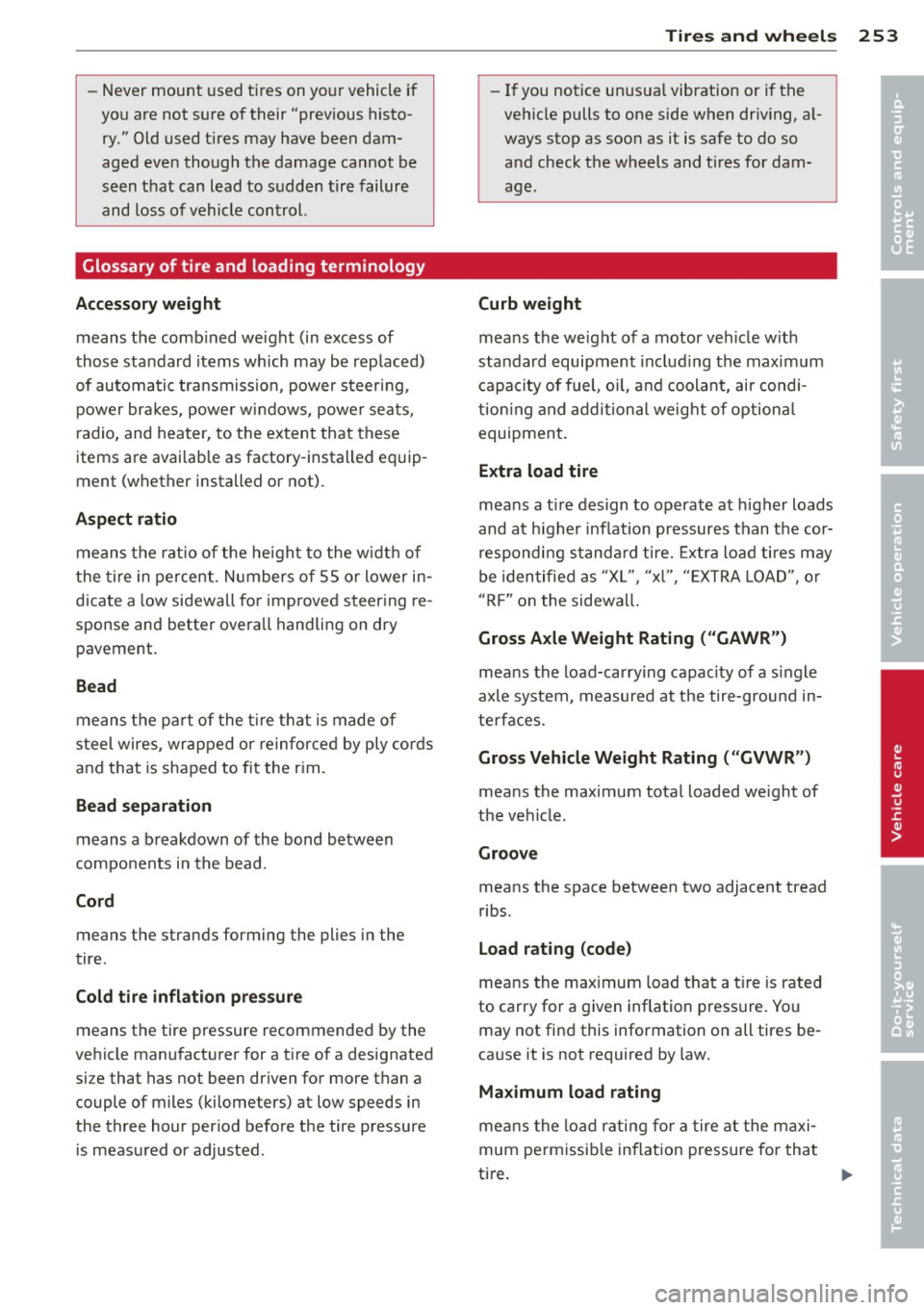
-Never mount used tires on yo ur vehicle if
you are not sure of their "previous histo
ry." Old used tires may have been dam
aged even though the damage cannot be
seen that can lead to sudden tire failure
and loss of vehicle control.
Glossary of tire and loading terminology
Accessory weight
means the comb ined weight (in excess of
those standard items wh ich may be rep laced)
of automa tic tra nsmission, power steering,
power br akes, power w indows, power sea ts,
radio, and heater, to the ex tent that these
items are avai lab le as factory -installed equip
ment (whether installed or not).
Aspect ratio
means the rat io of the height to the w idt h of
the tire in percent. Numbers of 55 or lower in
d icate a low sidewall fo r improved s teer ing re
sponse and better overall handling on dry
pavement.
Bead
means the pa rt of the t ire t hat is made o f
s teel wires, wrapped o r rein force d by ply cor ds
and that is shaped to fit the r im.
Bead separation
means a b reakdown of the bond between
components in the bead.
Cord
means the strands forming the plies in the
tire.
Cold tire infl ation pressure
means t he tire pressure recommended by the
vehicle manufacturer for a t ire of a designated
size that has not been dr iven for more than a
couple of miles (kilometers) at low speeds in
the three hour period before the tire pressure
i s measu red or adjusted.
Tire s an d wheel s 253
-If you notice un usua l vibration or if the
veh icle pulls to one side when driv ing, a l
ways stop as soon as it is safe to do so and check the wheels and tires for dam
age.
Curb weight
mea ns the we ight of a motor ve hicle w it h
standard equipment in cl ud ing t he maximum
capa city of fuel, o il, and coolant, ai r cond i
tion ing a nd addi tional weig ht o f optiona l
equipment .
Extra load tire
means a t ire design to operate at h igher loads
and at higher inflation pressures than the cor
respondi ng s tanda rd tire. Extra load tires may
be identified as "X L", "xl", "EXTRA LOA D", or
"R F" on the sidewall .
Gross Axle Weight Rating ("GAWR ")
mea ns the load-carry ing capac ity of a s ingle
axle system, measured at the tire-ground in
te rfaces.
Gross Vehicle Weight Rating ( "GVWR ")
means the maximum total loaded we ight of
t h e ve hicle.
Groove
means the space between two adjacent tread
ribs.
Load rating (code )
means the maximum load tha t a t ire is rated
to carry for a given inflation pressure. Yo u
may not find this information on all tires be
ca use it is not required by law.
Maximum load rating
me ans the loa d ra ti ng f or a t ire at the maxi
mum pe rm issi ble inflat ion pressure for that
ti re .
•
•
...
Page 256 of 316
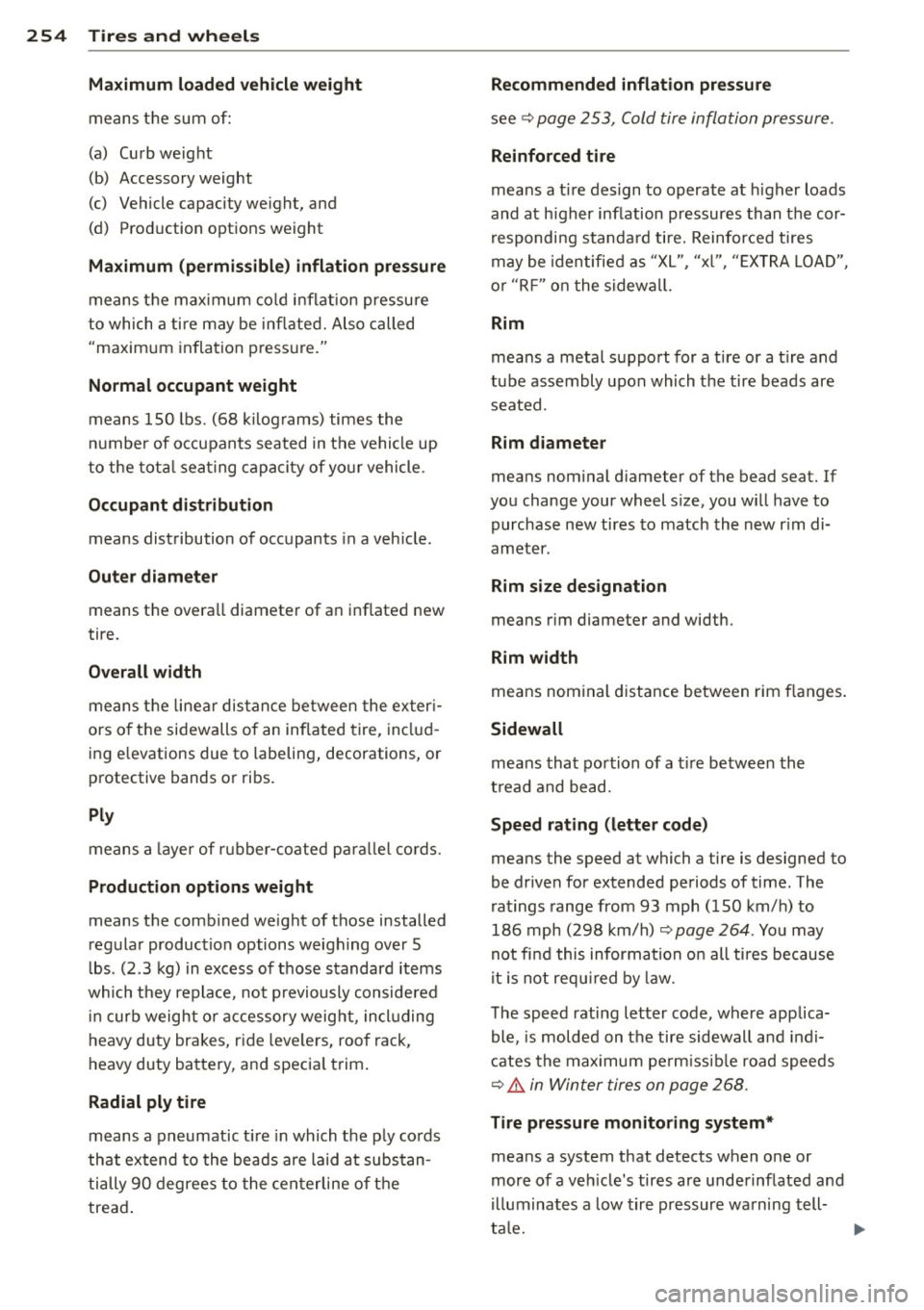
254 Tires and wheels
Maximum loaded vehicle weight
means the sum of:
(a) Curb weight
(b) Accessory weight
(c) Vehicle capacity weight, and
(d) Production options weight
Maximum (permissible) inflation pressure
means the maximum cold inflation pressu re
to which a tire may be inflated. Also called
"maximum inflation p ressure."
Normal occupant weight
means 150 lbs. (68 kilograms) times the
number of occupants seated in the vehicle up
to the total seating capacity of your vehicle.
Occupant distribution means distribution of occupants in a vehicle .
Outer diameter means the overa ll diameter of an inf lated new
tire.
Overall width
means the linear distance between the exteri
ors of the sidewalls of an inflated tire, includ
ing e levations due to labeling, decorations, or
protective bands or ribs.
Ply
means a layer of rubber-coated parallel cords.
Production options weight
means the comb ined weight of those installed
regular production options weighing over 5
lbs . (2 .3 kg) in excess of those standard items
which they replace, not previously considered
in curb weight or accessory weight, including
heavy duty brakes, r ide leve lers, roof rack,
heavy duty battery, and specia l trim .
Radial ply tire
means a pneumatic tir e in which the p ly cords
that extend to the beads are laid at substan
tially 90 degrees to the centerline of the
tread . Recommended inflation pressure
see
~
page 253, Cold tire inflation pressure.
Reinforced tire
means a t ire design to operate at higher loads
and at h igher inflation pressures than the cor
responding standard tire. Reinforced tires
may be identified as "XL", "xl", "EXTRA LOAD",
o r "R F" on the sidewall.
Rim
means a metal support for a tire or a t ire and
tube assembly upon which the tire beads are
seated.
Rim diameter
means nom inal d iameter of the bead seat.
If
you change your wheel s ize, you will have to
purchase new tires to match the new rim di
ameter .
Rim size designation
means rim diameter and width.
Rim width
means nominal distance between rim flanges.
Sidewall
means that portion of a tire between the
t read and bead.
Speed rating (letter code)
means the speed at which a tire is designed to
be driven for extended periods of time. The
ratings range from 93 mph (150 km/h) to
186 mph (298 km/h)
~ page 264 . You may
not find this information on all tires because
it is not requ ired by law.
The speed rating letter code, where applica
ble , is molded on the tire sidewall and indi
cates the max imum perm issible road speeds
~ A in Winter tires on page 268.
Tire pressure monitoring system*
means a system that detects when one or
more of a veh icle's tires are underinflated and
illuminates a low tire pressure warning tell
tale.
Page 257 of 316
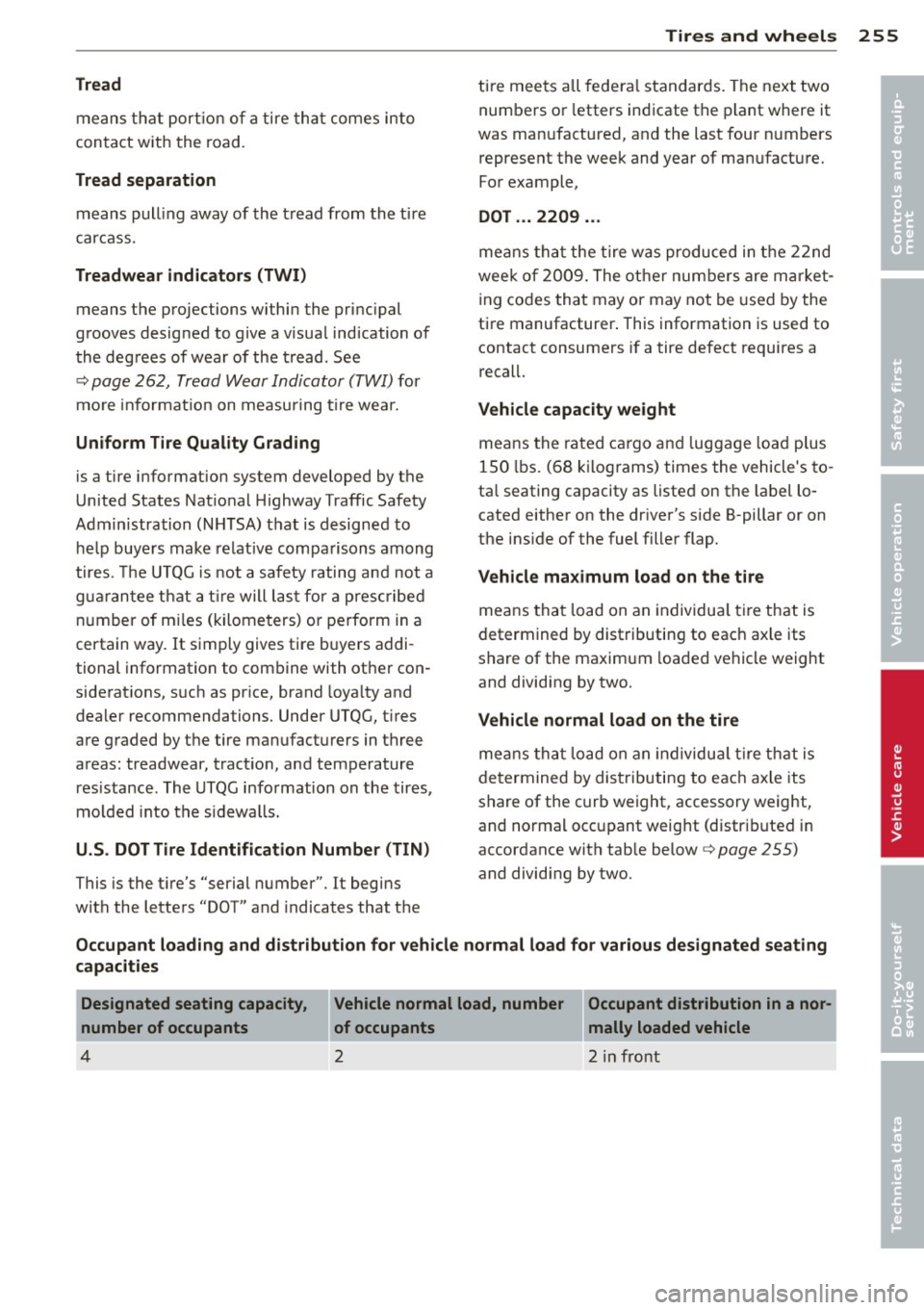
Tires and wheels 255
Tread
means that portion of a tire that comes into
contact with the road.
Tread separation
means pull ing away of the tread from the tire
carcass .
Treadwear indicators (TWI)
means the projections within the principal
grooves designed to give a visual indication of
the degrees of wear of the tread. See
c:> page 262, Tread Wear Indicator (TWI) for
more informat ion on measuring tir e wear.
Uniform Tire Quality Grading
is a tire information system developed by the
United States National Highway Traffic Safety
Administration (NHTSA) that is designed to help buyers make relative comparisons among
tires. The UTQG is not a safety rating and not a
guaran tee that a tire will last for a prescribed
number of miles (kilometers) or perform in a
certain way.
It simply gives tire buyers addi
tional information to combine with other con
siderat ions, such as pr ice, brand loya lty and
dealer recommendations. Under UTQG, tires
are graded by the tire manufacturers in three
areas: treadwear, traction, and temperature
res istance . The UTQG information on the tires,
mo lded into the sid ewa lls.
U.S . DOT Tire Identification Number (TIN)
This is the t ire's "serial number". It begins
with the letters "DOT" and indicates that the tire
meets all federal standards. The next two
numbers or letters indicate the plant where it
was man ufactured, and the last four numbers
represent the week and year of man ufacture.
For example,
DOT . .. 2209 ...
means tha t the tire was produced in the 22nd
week of 2009. The other numbers are market
ing codes that may or may not be used by the
tire manufacturer . This information is used to
contact consumers if a tire defect requires a
recall.
Vehicle capacity weight
means the rated cargo and luggage load plus
150 lbs.
(68 kilograms) times the vehicle's to
ta l seating capacity as listed on the label lo
cated either on the driver's side B-pillar or on
the inside of the fuel filler flap.
Vehicle maximum load on the tire
means that load on an individua l tir e that is
determined by distributing to each ax le its
share of the maximum loaded vehicle weight
and dividing by two.
Vehicle normal load on the tire
means that load on an individua l tir e that is
determined by distributing to each axle its
share of the curb weight, accessory weight,
and normal occupant weight (distributed in
accordance with tab le below
c:> page 255)
and dividing by two.
Occupant loading and distribution for vehicle normal load for various designated seating
capacities
Designated seating capacity,
number of occupants
4
Vehicle normal load, number Occupant distribution in a nor-
of occupants _____ mally loaded vehicle
2 2 in front
•
•
Page 258 of 316
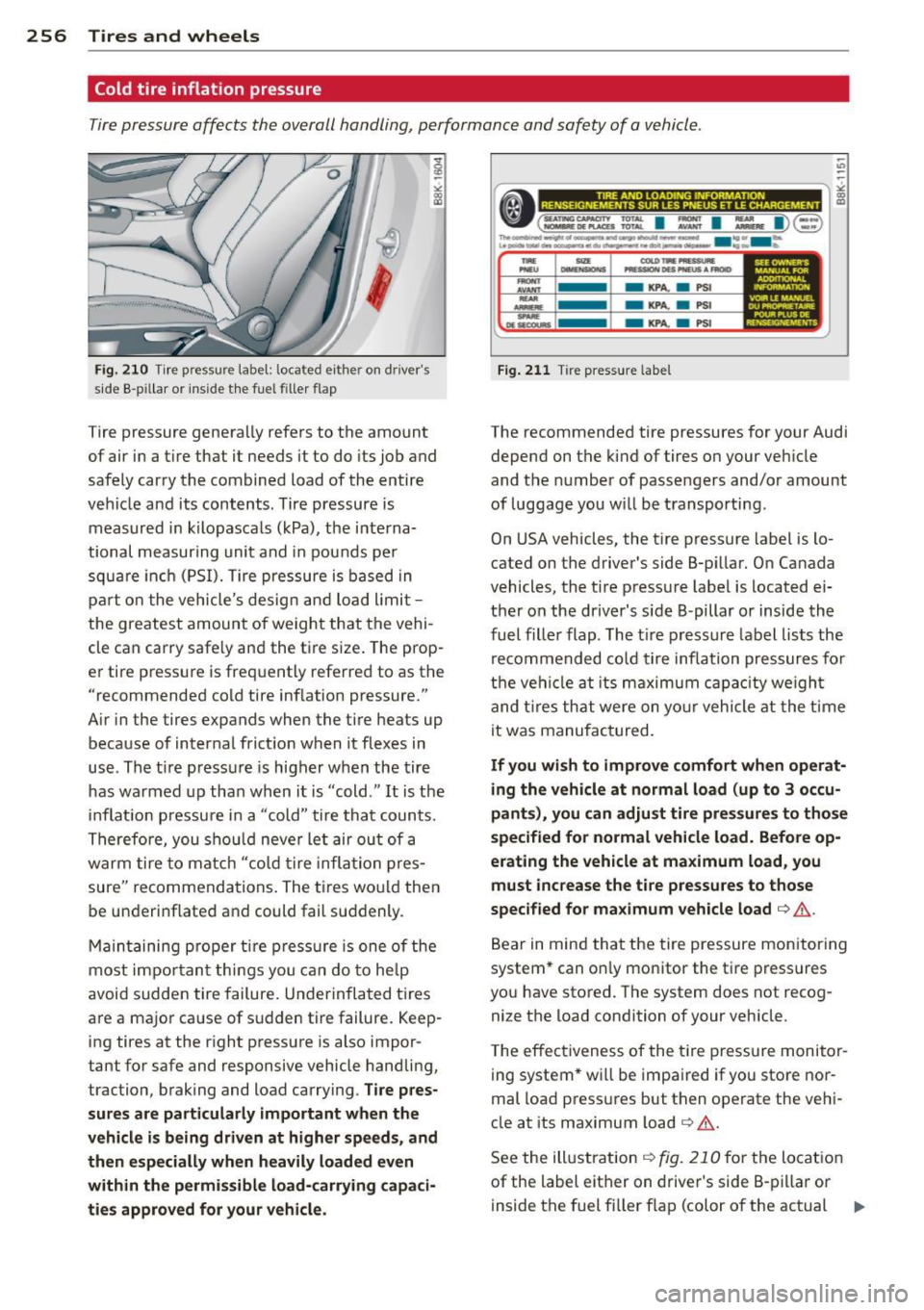
256 Tires and wheels
Cold tire inflation pressure
Tire pressure affects the overall handling, performance and safety of a vehicle.
Fig. 210 Tire p ress ure labe l: loca ted e ith er on d river 's
side 8 -pillar or ins ide t he fue l filler flap
Tire pressure genera lly refers to the amount
of air i n a t ire that it needs it to do its job and
safely carry the combined load of the entire
vehicle and its contents . Tire pressure is
measured in kilopasca ls (kPa), the inte rna
tional measuring unit and in pounds pe r
squa re inch ( PSI). Tire pressure is based in
pa rt o n the vehicle's design an d load limit
the greatest amount of weight that the vehi
cle can carry safe ly and the t ire size . The prop
er tire pressure is freq uently referred to as the
"recommended cold tire inf lation pressure."
A ir in the tires expands when the tire heats up
because of internal frict ion when it flexes in
use . The t ire p ress ure is higher when the tire
h as warmed up than when i t is "cold ." It is the
in flat ion pressu re i n a "cold " tire that coun ts.
T herefore, you sho uld neve r let air ou t of a
warm tire to match " co ld tir e infla tion pres
sure" recommendations . The ti res wo uld then
be underinflated and could fail su ddenly .
M ain taining p roper t ire pr es su re is one o f the
most impor tan t things you can do to he lp
avoid sudden tire failure. Underinfla ted ti res
a re a major ca use of s udden tire failure. Keep
ing tires at the r ight pressure is also impor
tant for safe and responsive vehicle handling,
traction, braking and load carrying .
Tire pres
sur es are particularly important when th e
vehicle is being driven at higher speeds , and
then especially when heav ily loaded even
w ithin the permissible load -carrying capaci
tie s approved for y our vehicle .
,;
•(=~ : I : I :,.. I)@ ~
The~-----~---w-o- ....... -e.....i -·· - u ........ -.-..,.0, ... -....,.,...tot~---....... ._.,. -..
....
-..... ...........
- KPA. a PSI
- KPA.
a PSI
- KPA. a PSI
Fig. 21 1 Tir e pressure la bel
SU OWNER'S MANUAl FOR AD0"10NAL l10N VOl!ILEMANU£1. DU _,...,
POUR Pl.US DE
REHSEKi.\'IEME NTS
The recommended tire pressures for your Audi
depend on t he kind of tires o n your veh icle
and the numbe r of passengers and/or amount
of luggage you w il l be transporting .
On USA vehicles, the t ire pressure label is lo
cated on the driver's side B-p illar. On Canada
vehicles, the tire press ure label is located ei
ther on the dr iver's s ide B-pillar or inside the
fuel fille r flap. The t ire press ure l abel lists the
recommended co ld tire inflation pressures for
t h e veh icle at its ma ximum ca pa ci ty we igh t
and t ires th at were on yo ur vehicle at the t ime
it was manufac tured.
If you wish to improve comfort when operat
ing the vehicle at normal load (up to 3 oc cu
pant s), you can adjust tire pre ssures to those
specified for normal vehicle lo ad. Before op
erating the vehicle at maximum load, you
must increase the ti re pressures to those
specified for ma ximum veh icle load ¢.&..
Bear in mind that the tire pressure mon itor ing
system * can o nly monitor the tire press ures
yo u have sto red. The system does not recog
ni ze the load condition of your vehicle.
T he effectiveness of the tire press ure monitor
ing system * w ill be impa ired i f you store nor
mal load press ures but then operate the veh i
cle at its maximum load
¢ .&. .
See the ill ustration ¢ fig. 210 fo r the location
of the label eit her on driver's side B -p ill ar or
i nside the fuel fi ller flap (color of the actual
IJI>
Page 259 of 316
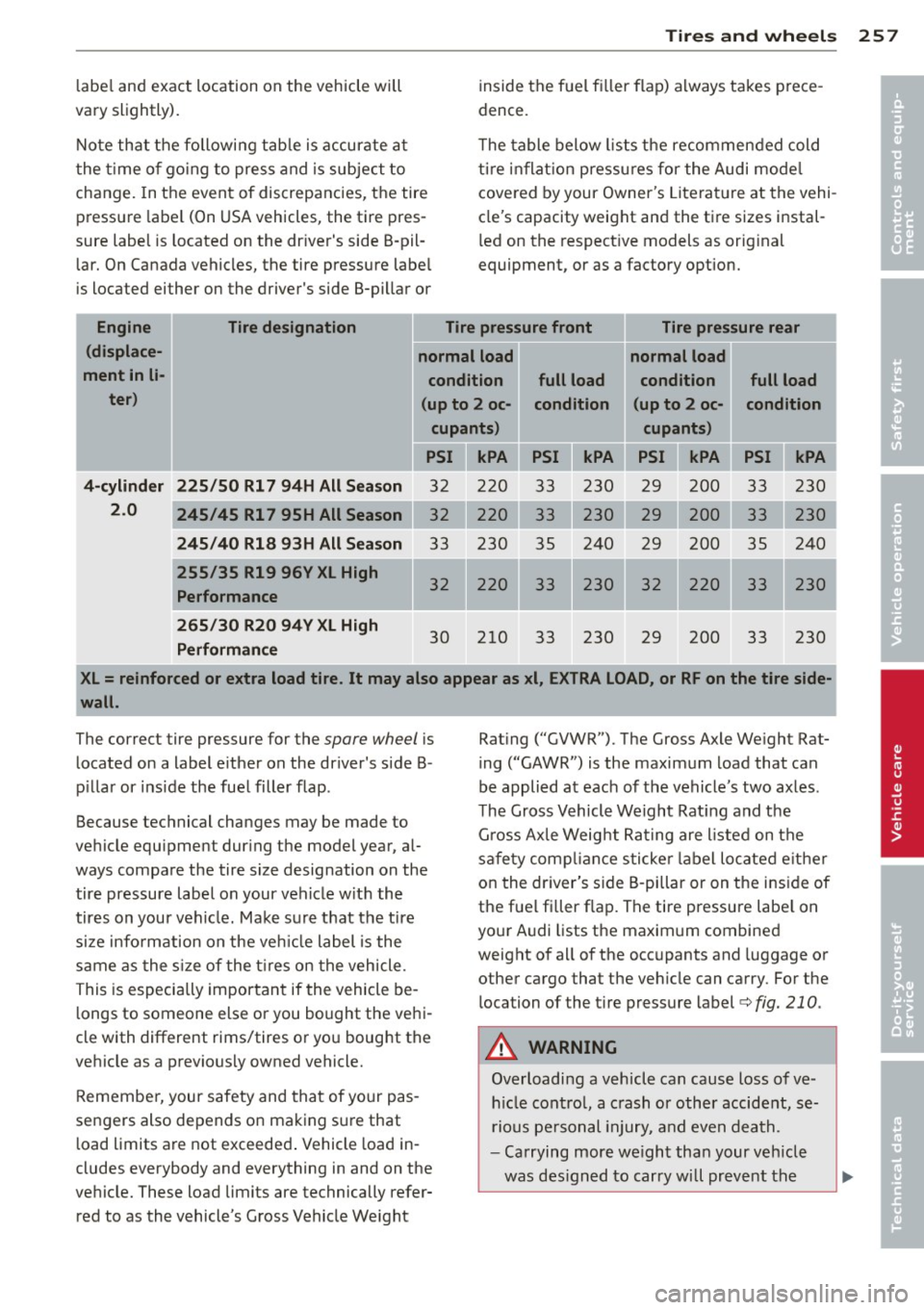
Tires an d wheel s 257
labe l and exact location on the vehicle wi ll
va ry slightly). inside the f
uel fi ller flap) always takes p rece
dence.
Note that the f ollowing tab le is accurate at
t he t ime o f go ing to press and is subject to
change. In the event of discrepancies, the tire
pressure label (On USA vehicles, the tire pres
sure label is located on the dr iver's side B-pil
lar. On Canada vehicles, the tire pre ssure labe l
is located either on the driver's side B-pillar or T
he table below lists the recommended cold
ti re in flat ion p ressu res for the Audi mode l
cove red by your Owner 's Literat ure at the vehi
cle's capacity weight and the t ire sizes instal
l ed on the respect ive models as orig inal
equipment, or as a factory option.
Engine Tire designation Tire pressure front Tire pressure rear
( displace-
normal load normal load
ment in li- condition full load condition
full load
ter) (up to 2 oc-condition (up to 2 oc- condition
cupant s) cupants)
PSI kPA PSI kPA PSI kPA
4-cylinder 225 /50 Rl 7 94H All Season
230
33 230
2
.0
245/45 Rl 7 95H All Season 230
245 /40 R18 93H All S eason 33 230 35 240 29 200 35 240
255 /35 R19 96V XL High 32 220 33 230 32 220 33 230 Performance
265 /30 R20 94V XL H igh
Perfo rmance
30 210 33 230 29 200 33 230
XL= reinforced or extra load tire. It may also appear as xl , EXTRA LOAD, or RF on the tire side
wall.
The correct tire pressure for the spare wheel i s
located on a label e ither on the driver's side B
p illar or ins ide the fuel filler flap .
Because technical changes may be made to
vehicle equ ipment dur ing the model year, a l
ways compare the tire s ize designation on the
tire pressure label on your vehicle w it h the
tires on your veh icle. Ma ke sure that the tire
size info rmation on the ve hicle label is the
s a me as the s ize of the t ires on the vehicle.
This is especia lly important if the vehicle be
l ongs to someone else or you bought the vehi
cle with different rims/tires o r you bought the
vehicle as a previously owned vehicle.
Remember, your safety and that of your pas
sengers also depends on mak ing su re that
l oad limits a re not exceeded . Vehicle load in
cludes everybody and everything in and on the
ve hicle. These load limits are technically refer
red to as the vehicle's G ross Vehicle We ight Rat
ing ("GVWR"). The Gross Axle We ight Rat
ing ("GAWR") is the maximum load that can
be applied at each of the vehicle's two axles .
T he Gross Vehicle Weight Rat ing and the
G ross Ax le Weig ht Rating are listed on the
sa fe ty comp liance sticke r label lo cated e ither
on the dr iver's s ide B-pillar or on the ins ide of
the fue l filler flap. The tire pressure labe l on
your A udi lists the maximum combined
weight of all of the occ upants and luggage or
other cargo that the veh icle can carry . For t he
loca tion of the t ire p ressure label¢
fig. 210.
A WARNING
Overloading a vehicle can cause loss of ve
h icle cont ro l, a c rash or other accide nt, se
rious pe rsonal injury, and even death.
- Ca rrying more we ight than your veh icle
was des igned to carry will prevent the
1
I
•
•
Page 260 of 316
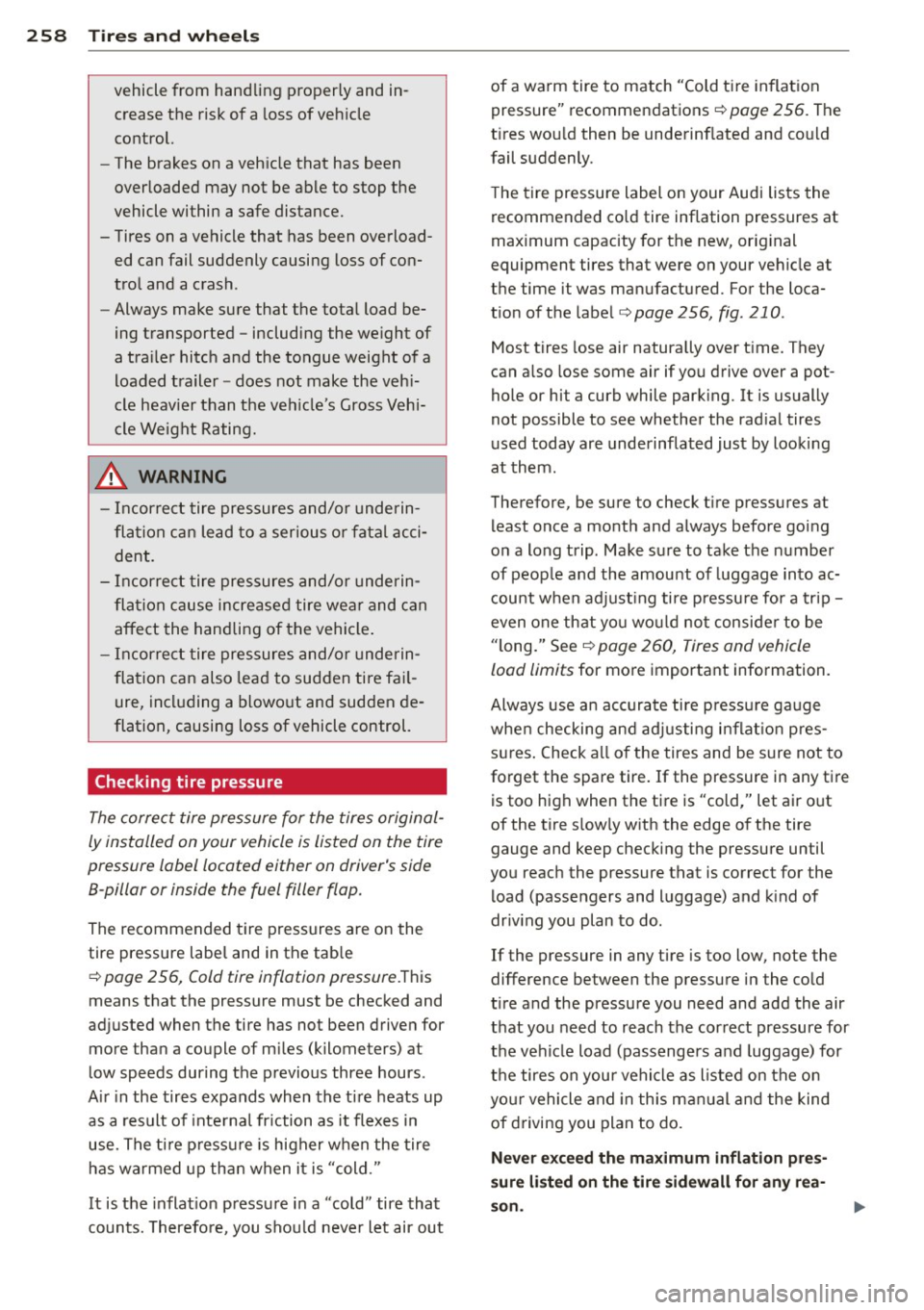
258 Tire s and whee ls
vehicle from handling properly and in
crease the risk of a loss of vehicle
control.
- The brakes on a vehicle that has been
overloaded may not be able to stop the
vehicle within a safe distance.
- Tires on a vehicle that has been overload ed can fail suddenly causing loss of con
tro l and a crash.
- Always make sure that the tota l load be
ing transported -including the weight of
a tra iler hitch and the tongue weight of a
loaded trailer -does not make the veh i
cle heav ier than the veh icle's Gross Vehi
cle Weight Rating.
_& WARNING
- Incorrect tire pressures and/or underin
flation can lead to a serious o r fatal acci
dent.
- Incorrect tire pressures and/or underin
flation cause increased tire wear and can
affect the handling of the vehicle.
- Incorrect tire pressures and/or underin
flation can also lead to sudden tire fai l
ure, including a blowo ut and sudden de
flation, causing loss of vehicle control.
Checking tire pressure
.
The correct tire pressure for the tires original
ly installed on your vehicle is listed on the tire
pressure label located either on driver's side 8-pillar or inside the fuel filler flap.
The recommended tire pressures are on the
tire pressure labe l and in the tab le
¢ page 256, Cold tire inflation pressure .This
means that the pressure must be checked and
adjusted when the tire has not been driven for
more than a couple of miles (kilometers) at
low speeds during the previous three hours .
A ir in the tires expands when the tire heats up
as a result of inte rna l fr iction as it flexes in
use. The ti re p ress ure is higher when the tire
has warmed up than when it is "cold."
It is the inflat ion pressure in a "cold" tire that
counts. Therefo re, you should never let air out of a warm tire to match "Cold tire
inflation
pressure" recommendations ¢
page 256. The
t ires wo uld then be underinf lated and co uld
fail suddenly.
The tire pressure label on your Audi lists the
recommended co ld tire inflation pressures at
maximum capacity for the new, orig inal
equipment tires that were on your vehicle at
the time it was manufactured. For the loca
t ion of the labe l
¢page 256, fig . 210 .
Most tires lose air natura lly over t ime. They
can a lso lose some air if you drive over a pot
hole or hit a curb while park ing. It is usually
not possible to see whether the rad ial tires
used today are underinflated just by look ing
at them.
Therefore, be sure to check t ire pressures at
least once a month and a lways before going
on a long trip . Make sure to take the number
of peop le and the amount of luggage into ac
count when adjust ing ti re pressu re for a trip -
even one that yo u wou ld not consider to be
" long." See
¢ page 260, Tires and vehicle
load limits
for mo re important information.
Always use an accurate tire p ressu re ga uge
when checking and ad justing inflat ion pres
sures . Check a ll of the tires and be s ure not to
forget the spare tire. If the pressure in any tire
is too high when the tire is "cold," let air o ut
of the tire s low ly with the edge of the tire
gauge and keep checking the pressure until
you reach the pressure that is correct for the load (passengers and luggage) and k ind of
dr iv ing you plan to do .
If the pressure in any tire is too low, note the
difference between the pressure in the co ld
t ire and the pressure you need and add the air
that you need to reach the correct pressure for
the vehicle load (passengers and luggage) for
the tires on your vehi cle as listed on the on
yo ur vehicle and in th is m anu al and the kind
of d riving you plan to do.
Ne ver e xceed th e maximum infl ation pre s
sure lis ted o n the tir e side wall for any rea
s on.